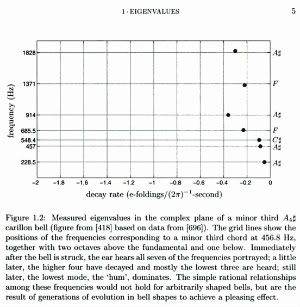Showing posts with label math. Show all posts
Showing posts with label math. Show all posts
Saturday, May 8, 2010
Frequency components of music
From Spectra and Pseudospectra; click for full size.
Measured eigenvalues in the complex plane of a minor third A4# carillon bell. The grid lines show the positions of the frequencies corresponding to a minor third chord at 456.8 Hz. together with two octaves above the fundamental and one below. Immediately after the bell is struck, the ear hears all seven of the frequencies portrayed; a little later, the higher four have decayed and mostly the lowest three are heard; still later, the lowest mode, the 'hum', dominates. The simple rational relationships among these frequencies would not hold for arbitrarily shaped bells, but are the result of generations of evolution in bell shapes to achieve a pleasing effect.
Seems like this format could make a nice interface for designing new sounds; someday I'd like to get around to recreating it.
Friday, July 3, 2009
23 Questions
Darpa's 23 mathematical challenges in modern scientific efforts, with a distinct emphasis on computational biology.
Larry Abbott's 23 questions in computational neuroscience.
23 is a reference to the father of all such lists, Hilbert's 23 problems posed to the International Congress of Mathematicians in 1900; these problems shaped much of 20th century mathematics, and some remain unresolved to this day.
Larry Abbott's 23 questions in computational neuroscience.
23 is a reference to the father of all such lists, Hilbert's 23 problems posed to the International Congress of Mathematicians in 1900; these problems shaped much of 20th century mathematics, and some remain unresolved to this day.
Labels:
compbio,
computing,
mad science,
math,
neuroscience,
research
Subscribe to:
Posts (Atom)
